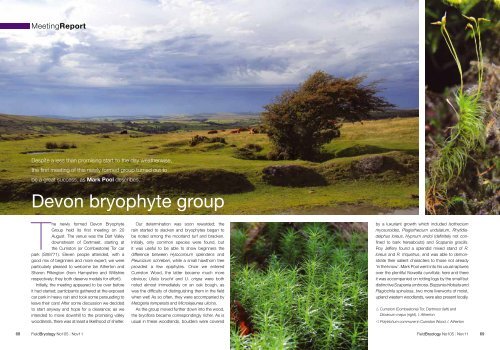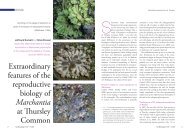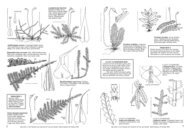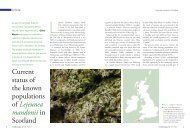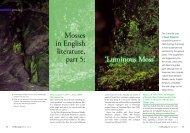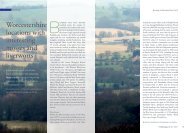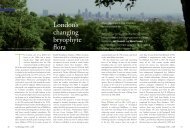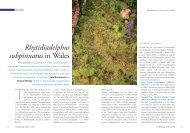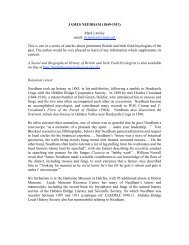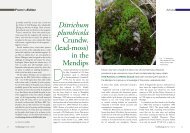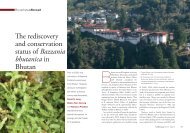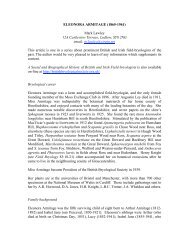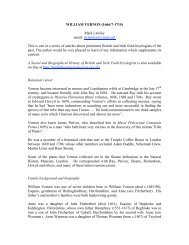Devon bryophyte group
Devon bryophyte group
Devon bryophyte group
Create successful ePaper yourself
Turn your PDF publications into a flip-book with our unique Google optimized e-Paper software.
MeetingReport<br />
Despite a less than promising start to the day weatherwise,<br />
the first meeting of this newly formed <strong>group</strong> turned out to<br />
be a great success, as Mark Pool describes.<br />
<strong>Devon</strong> <strong>bryophyte</strong> <strong>group</strong><br />
The newly formed <strong>Devon</strong> Bryophyte<br />
Group held its first meeting on 20<br />
August. The venue was the Dart Valley<br />
downstream of Dartmeet, starting at<br />
the Cumston (or Combestone) Tor car<br />
park (SX6771). Eleven people attended, with a<br />
good mix of beginners and more expert; we were<br />
particularly pleased to welcome Ian Atherton and<br />
Sharon Pilkington (from Hampshire and Wiltshire<br />
respectively; they both deserve medals for effort!).<br />
Initially, the meeting appeared to be over before<br />
it had started; participants gathered at the exposed<br />
car park in heavy rain and took some persuading to<br />
leave their cars! After some discussion we decided<br />
to start anyway and hope for a clearance; as we<br />
intended to move downhill to the promising valley<br />
woodlands, there was at least a likelihood of shelter.<br />
Our determination was soon rewarded; the<br />
rain started to slacken and <strong>bryophyte</strong>s began to<br />
be noted among the moorland turf and bracken.<br />
Initially, only common species were found, but<br />
it was useful to be able to show beginners the<br />
difference between Hylocomium splendens and<br />
Pleurozium schreberi, while a small hawthorn tree<br />
provided a few epiphytes. Once we entered<br />
Cumston Wood, the latter became much more<br />
obvious; Ulota bruchii and U. crispa were both<br />
noted almost immediately on an oak bough, as<br />
was the difficulty of distinguishing them in the field<br />
when wet! As so often, they were accompanied by<br />
Metzgeria temperata and Microlejeunea ulicina.<br />
As the <strong>group</strong> moved further down into the wood,<br />
the bryoflora became correspondingly richer. As is<br />
usual in these woodlands, boulders were covered<br />
by a luxuriant growth which included Isothecium<br />
myosuroides, Plagiothecium undulatum, Rhytidiadelphus<br />
loreus, Hypnum andoi (definitely not confined<br />
to bark hereabouts) and Scapania gracilis.<br />
Roy Jeffery found a splendid mixed stand of R.<br />
loreus and R. triquetrus, and was able to demonstrate<br />
their salient characters to those not already<br />
‘in the know’. Mark Pool went into his usual raptures<br />
over the plentiful Nowellia curvifolia; here and there<br />
it was accompanied on rotting logs by the small but<br />
distinctive Scapania umbrosa. Bazzania trilobata and<br />
Plagiochila spinulosa, two more liverworts of moist,<br />
upland western woodlands, were also present locally.<br />
n Cumston (Combestone) Tor, Dartmoor (left) and<br />
Dicranum majus (right). I. Atherton<br />
v Polytrichum commune in Cumston Wood. I. Atherton<br />
68 FieldBryology No105 | Nov11 FieldBryology No105 | Nov11 69
Meeting report – <strong>Devon</strong> <strong>bryophyte</strong> <strong>group</strong><br />
Largely to escape the local midges, lunch was<br />
taken on boulders in and by the river; the rain had<br />
now stopped and the weather was steadily turning<br />
sunny. The rocks again produced a good variety of<br />
species: common ones like Pogonatum urnigerum<br />
and Thamnobryum alopecurum, and rarer ones<br />
such as Isothecium holtii (locally abundant on the<br />
sides of boulders) and (rather surprisingly this far<br />
up-river) Porella pinnata. Marsupella emarginata<br />
var. aquatica (amazingly wanted as a South <strong>Devon</strong><br />
‘de-bracketing’) was also collected here and was<br />
subsequently confirmed as correct.<br />
After lunch, the <strong>group</strong> started up the valley of<br />
the Aller Brook, an attractive tributary stream with<br />
a number of small waterfalls. Here Sharon made<br />
the best discovery of the day, a good stand of<br />
Sphagnum girgensohnii (again later accepted as<br />
a voucher) at the foot of a steep bank. This was<br />
v Heterocladium heteropterum var. heteropterum (top)<br />
and Scapania nemorea (middle) in Cumston Wood.<br />
I. Atherton<br />
, Identifying epiphytes. From left to right, Nigel Pinhorn,<br />
Roy Jeffrey and Jeremy Barker, with BBS Field Guide!<br />
I. Atherton<br />
n Sharon’s find of the day: Sphagnum girgensohnii,<br />
Cumston Wood. I. Atherton<br />
n Down by the river. Isothecium holtii (top), Pogonatum<br />
urnigerum (bottom). I. Atherton<br />
, The <strong>group</strong>. From left to right: Jo Marsh, Andrew Cunningham, Christine Preston, David Trude, Jeremy Barker (at rear),<br />
Tim Purches, Sharon Pilkington, Mark Pool, Nigel Pinhorn and Roy Jeffery (pointing to the first S. girgensohnii patch<br />
found). I. Atherton<br />
70 FieldBryology No105 | Nov11 FieldBryology No105 | Nov11 71
Meeting report – <strong>Devon</strong> <strong>bryophyte</strong> <strong>group</strong><br />
n Sphagnum palustre. I. Atherton<br />
the first confirmed record of the species from<br />
the entire south-west peninsula, and therefore a<br />
very good find; maybe we can now turn it up in<br />
v.-c. 4? Sharon also discovered a good patch of<br />
Loeskeobryum brevirostre on a nearby boulder; this<br />
was later unwittingly sat on by Mark, but mercifully<br />
without terminal damage to either party. A search<br />
of the stream gully for Jubula proved unsuccessful,<br />
but compensation came later in the shape of further<br />
large colonies of Sphagnum girgensohnii, some<br />
several metres across; we ‘locals’ must surely have<br />
been overlooking this in the past?<br />
Most of the <strong>bryophyte</strong> species in the Aller Brook<br />
valley were the same as those found during the<br />
morning, but the small liverwort Plagiochila punctata,<br />
seen on a few trees and on a mossy boulder, was<br />
an interesting extra. On emerging from the wood,<br />
into bright sunshine, a small amount of Thuidium<br />
delicatulum was found in a flush. Neighbouring<br />
willow trees were searched, unsuccessfully, for<br />
Colura calyptrifolia; this is becoming quite frequent<br />
on willows in parts of Cornwall, but so far the only<br />
<strong>Devon</strong> record is from Nothofagus at Fernworthy.<br />
Neckera pumila, a local species on Dartmoor,<br />
72 FieldBryology No105 | Nov11<br />
provided some consolation. Continuing on up the<br />
brook, now mostly on open moorland, Roy Jeffery<br />
was able to introduce the beginners to some of the<br />
common species of Sphagnum on the way back to<br />
the cars.<br />
The consensus among those attending was that<br />
the day had gone well, with beginners learning a<br />
considerable amount and some very useful records<br />
being made; in addition to the two vice-county<br />
vouchers, there were a surprising number of new<br />
tetrad ‘ticks’ for the county database from what had<br />
previously been thought to be a well-worked area!<br />
The second meeting of the Group was held at<br />
Berry Head (near Brixham) on 29 October. Full<br />
details of all future meetings of the <strong>group</strong> should<br />
soon be appearing on the BBS website. In the<br />
meantime, interested people should contact Nigel<br />
Pinhorn (devonnaturewalks@btinternet.com) or Tim<br />
Purches (tim.purches@talk21.com).<br />
Mark Pool<br />
e mark.pool@care4free.net<br />
, Bazzania trilobata. I. Atherton


